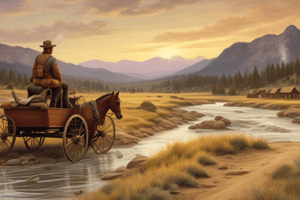Podcast
Questions and Answers
What was the primary impact of the Gold Rush on California?
What was the primary impact of the Gold Rush on California?
- Decrease in local Native American populations
- Stagnation of the economy in the region
- Decline of mining activities
- Increased population and establishment of towns (correct)
Which factor contributed to the end of the Open Range?
Which factor contributed to the end of the Open Range?
- Overgrazing and harsh winters (correct)
- Government incentives for large ranches
- Increased migration of settlers to the East
- Expansion of forested areas
Which of the following statements accurately describes boomtowns?
Which of the following statements accurately describes boomtowns?
- They developed around agricultural resources rather than mining.
- They were always economically successful and stable over time.
- They were permanent settlements established by government mandate.
- They experienced rapid growth due to mining but often became abandoned. (correct)
What role did Chinese immigrants play in the construction of the Transcontinental Railroad?
What role did Chinese immigrants play in the construction of the Transcontinental Railroad?
What strategies did railroads use to attract settlers to the West?
What strategies did railroads use to attract settlers to the West?
What was the main intention of the Dawes Act?
What was the main intention of the Dawes Act?
Which of the following challenges did homesteaders NOT face according to the content?
Which of the following challenges did homesteaders NOT face according to the content?
What was one significant goal of the Ft. Laramie Treaty?
What was one significant goal of the Ft. Laramie Treaty?
How did Granger Laws aim to assist farmers?
How did Granger Laws aim to assist farmers?
What was a major effect of the Dawes Act on Native Americans?
What was a major effect of the Dawes Act on Native Americans?
Flashcards are hidden until you start studying
Study Notes
Importance of Mining in Settling the West
- Mining was crucial for westward expansion in the United States, attracting settlers seeking precious minerals.
- The discovery of gold and silver led to the establishment of towns and infrastructure rapidly.
The Gold Rush
- The Gold Rush occurred from 1848 to 1855, triggered by gold found at Sutter's Mill in California.
- This event resulted in a population surge in California, with many towns and cities emerging quickly and significant conflicts with Native Americans.
Boom/Bust Towns
- Boomtowns emerged suddenly near mining sites, experiencing rapid growth.
- Once resources were exhausted, these towns often became "bust towns," resulting in abandonment.
Importance of the Transcontinental Railroad in Settling the West
- Completed in 1869, the Transcontinental Railroad linked the Eastern U.S. to the West, improving travel and goods transport.
- Facilitated migration of settlers, troop movements, and economic advancement in the West.
Importance of Chinese Immigrants
- Chinese immigrants were essential in building the Transcontinental Railroad, particularly on the Central Pacific segment.
- Despite facing severe discrimination, their labor was critical for the railroad's completion.
Push/Pull Factors for People Migrating West
- Push factors included overcrowding in cities, unemployment, poverty, and religious persecution, prompting migration.
- Pull factors comprised land ownership opportunities from the Homestead Act, wealth prospects from mining, and the allure of adventure.
Incentives and Advertisements Used by Railroads to Get People to Come West
- Railroads enticed settlers with affordable land, travel discounts, and promotions portraying the West as a land of opportunity.
- Advertising often exaggerated advantages to encourage westward migration.
Open Range
- The Open Range was vast public lands allowing unrestricted grazing for cattle, vital to the cattle industry in the late 19th century.
The End of the Open Range
- Overgrazing, severe winters, and barbed wire's introduction contributed to the decline of the Open Range, limiting cattle movement.
Railroad’s Impact on Native Americans
- Railroad construction displaced Native American tribes and devastated buffalo herds relied upon by these tribes.
- Increased settler encroachment led to heightened conflicts with Native Americans.
Intentions of the Dawes Act and the Morrill Act
- The Dawes Act aimed to assimilate Native Americans by allocating individual plots of tribal land, promoting farming.
- The Morrill Act of 1862 granted land for colleges emphasizing agriculture and mechanical arts, enhancing education in the West.
Provisions for Homesteaders
- The Homestead Act of 1862 provided 160 acres of public land to settlers for a small fee, contingent on residency, improvements, and farming for five years.
Problems Facing Homesteaders
- Homesteaders confronted severe weather, isolation, resource scarcity, unfamiliar farming challenges, and conflicts with Native Americans.
Granger Laws
- Enacted in the late 19th century, Granger Laws aimed to regulate exploitative railroad rates and practices.
- These laws successfully reduced transportation costs for farmers but faced legal challenges.
Goal of the Ft. Laramie Treaty
- The Treaty of Ft. Laramie (1851, 1868) sought to define Native American tribal boundaries for protection against settlers and supply provisions.
- The treaty was frequently violated by the U.S. government.
Government Agencies that Dealt with Native Americans
- The Bureau of Indian Affairs (BIA) managed U.S. government relations with Native American tribes.
- The BIA often implemented harmful policies toward Native Americans.
Intentions and Effects of the Dawes Act
- Aimed to assimilate Native Americans by promoting individual land ownership and farming practices.
- It resulted in significant loss of tribal land and culture, with many Native Americans being coerced or defrauded into selling their land.
Bimetallism/Free Silver Movement
- Bimetallism was a monetary system where currency value was based on both gold and silver.
- The Free Silver movement pushed for the unlimited coinage of silver, advocating increased money supply to support farmers and alleviate economic distress.
Studying That Suits You
Use AI to generate personalized quizzes and flashcards to suit your learning preferences.




